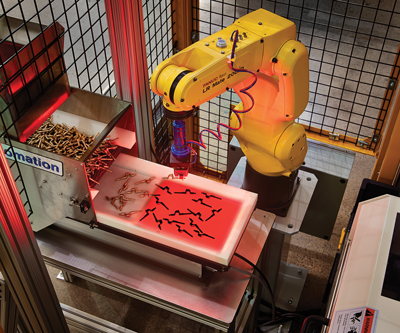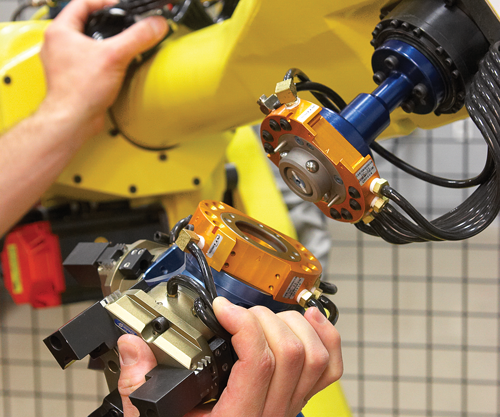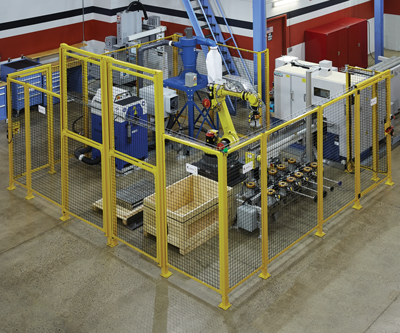Developing a Company Plan for Robotics
It’s a good time for shops to re-evaluate the impact robotic automation can have on productivity.
In the 1980s a wholesale technology shift took place in the precision machining industry. I was “in the trenches” as thousands of traditional machine tools were replaced by hundreds of CNC machines all over this country.
I believe we are now in another wholesale technology shift. Considering how CNC control changed what happens inside the machine tool, robotic automation is having a similar impact on what happens to that process on the outside of the machine tool. Robotics allow the combination of precision machining control with the part-exchange sequence still common today. Along with bar feeders, pallet changers and gantry loaders, robotic automation lends an additional ability of using lower cost machine tools in combination with lower cost robotic systems to help businesses be more competitive in today’s global market.
Featured Content
Traditional Vs. Collaborative Robots
Today, robotic machine-tending has garnered a lot of interest, from the traditional industrial robots to the exciting field of collaborative robots. The concept of collaborative robotics is to allow robots to work side by side with people without the need for guarding. By allowing a robot to work collaboratively, the need for traditional perimeter fencing is removed. Or is it?
Today’s reality of business survival means finding and using all ways to reduce the cost of manufacturing. Keeping this in mind, the strategy is more about minimizing the time required for people to tend the machine tool, more so than the implementation of automation that merely works alongside the people. This approach may not work best for all manufacturing positions, but it is generally most effective for our segment of manufacturing: precision machining. Given the shortage of qualified machinists and machine operators, business survival depends on getting more productivity from the resources (people) currently in place. Rather than eliminating jobs, robotics allow experienced resources to expand opportunities within the manufacturing environment.
Risk Assessment and Safety
Currently, industrial robotic systems mitigate potential risks by performing risk assessments. Potential points that might cause injury are identified, and steps are taken to protect against each risk. The most obvious protection is perimeter guarding and controlled access gates. Even though the collaborative robot is “safe,” it might very well be connected to other sub-systems that still need to be evaluated and addressed. The risk assessment is the best tool to do this. Some examples of concerns that might be identified and addressed in a risk assessment include door pinch points, sharp edges, dropped parts and coolant carry-out.
Safety with Collaborative
The appeal of collaborative robots is the suggestion that guarding is no longer necessary. While it’s true that the robot itself can be certified to be safe, the entire system must also be safe. The fact that the robot is safe does not protect personnel against other hazards that are likely to be present in the machining cell. To this end, perimeter fencing is the single most cost effective way to contain these hazards.
Equipment is available, however, for shops that require close human interaction with robotic systems. Dual check safety (DCS) is a way to allow safe zones to be defined into which robot motion is not allowed in all operating modes of an installed robot. Area scanners are also available that can detect the presence or absence of approaching people and slow down or stop the robot when certain proximity boundaries are entered. Because these area scanners also monitor when the risk is withdrawn, the operating condition can be restored without causing any alarms or requiring a system restart. Adding this type of technology can help avoid the common problems that happen with mid-cycle restarts. This type of system can allow an operator to access features such as the control pendant on a machine tool without forcing a cycle stop and its associated restart problems.
Necessary Sub-Systems
Certain major sub-systems are required for a robot to be useful in tending a CNC machine tool. As fascinating as Honda’s Asimo humanoid robot is, with its ability to socialize and serve snacks and beverages, it’s not quite ready to be unplugged from the charging station and commanded to “go run that machine over there.”
A typical machine-tending system first requires the addition of sub-systems, which include:
- a fixed base or pedestal to anchor the robot in proximity to a CNC machine
- an end of arm tooling (EOAT) set that can be attached to the robot’s final faceplate
- the valve stack and sensors on the robot arm to allow the EOAT to actuate
- a device or system to bring raw material into the cell
- a door actuator to open and close the machine tool door
- a device or system to locate the part for robot pick-up
- a device to manipulate the workpiece (when necessary) between operations (Op. 10, Op. 20)
- workholding that can be opened/closed automatically (fixtures or chucks)
- a device or system to accumulate finished material
- the electrical interface needed to coordinate the robot to the CNC machine tool
- safety devices to address potential injuries (best identified by the risk assessment)
- the labor used in planning, assembling, wiring, programming, debugging and installing the cell for production operations
These sub-systems can have a significant effect on the cost of an automation system. The range in price can be quite large as a shop decides whether to purchase premium equipment or to make do, but the quality of a sub-system can have as much impact on operations as the robot itself. The complexity of an over-defined system should also be considered. Complex systems are difficult to keep running, difficult to set up and difficult to introduce new parts to. The largest negative cost in any system is the cost of unplanned downtime. Reliability and simplicity is essential, so shops should concentrate on keeping the machine “in-cycle” and worry less about keeping the robot busy by rinsing, sanding, measuring and packing parts.
Effect on Operations and Productivity
The beauty of an automated system (robotic or otherwise) is that it is predictable and reliable. Although a traditional machine operator can indeed beat the robot over a short span of time, an operator can’t keep up such a pace continually without rest. In almost every case, the addition of robotic automation to an existing process results in an eye-opening increase in daily production (the number of parts that can be shipped and paid for). A 25-percent increase is common, while productivity gains of 150 percent are possible—all without changing any cutting speeds or feed rates, but instead only through good process planning.
Attention should also be given to the relationship of non-cutting time to initial cost of components. A shop might be attracted by the initial cost of a $2,000 pneumatic door closer versus a servo-door actuator in the $10,000 price range. But a closer look at the overall return on investment provides a different perspective. The pneumatic actuator round trip time is typically 12 seconds and the servo-actuator is 2 seconds—a delta time savings of minus 10 seconds in exchange for a delta cost difference of plus $8,000. With a production rate of 50,000 door cycles (parts) per year and a shop rate of $65 per hour, the value of the 500,000 seconds that the servo-driven door actuator returns to the business is $9,028 (the first year, alone). This first-year increase in efficiency would generate a revenue increase of $1,028 over the cost difference of the slower, less expensive door actuator. Over a 10-year service life, taking no other factors into account, a given piece of equipment has capacity for an additional $90,278 of revenue, a pretty nice return on investment.
Production Rate, Walk-Away Time and Uptime
When planning for a system, a common request is for 24 hours of walk-away time. But only physical components, measured by space rather than time, can be placed in a cell, and these components, whatever their physical size, cannot grow or shrink to meet walk-away time demands. The amount of walk-away time is more dependent on the production rate and the space taken up by parts. In planning for walk-away time, the planned part cycle time needs to be calculated, allowing room to fit enough space to buffer enough parts to fill the time. It usually becomes a balancing act between floor space and production time. A high rate of efficiency (in the +90-percent range) can be achieved because the only stops are to replenish cutting tools, coolant, material and way oil. Collaborative cells most commonly have limited space for conveyor systems, so long periods of walk-away time require jobs with long cycle times.
Robotic System Portability
Pretty much any operation on the shop floor can benefit from increased flexibility. In the case of automation, an ideal arrangement would allow deployment of a system on one machine with the capability to easily move it to another if the need arose. Unfortunately, electrical connectivity and the physical limitations involved in moving complex equipment around the shop make such a move quite burdensome.
Similar to moving a bar feeder from one machine to another on a regular basis, a shop should carefully consider the complexity of moving an entire robotic system, however compact it might be, with any regularity. While the mechanical aspects of such a move are difficult enough, the electrical connection involves even more attention. Does the system use hydraulic or pneumatic clamping? What if an additional device is needed in the future? Is there one clamping sequence or four? To have portability, all of the connection issues need to be mapped in advance and each machine must be able to accept exchange commands from a common interface.
Emerging Developments
The technology within the industry is always evolving, and exciting developments related to flexibility and connectivity of devices within the shop are continuing to surface. New generations of CNCs are available to assist in robotic applications, both collaborative and traditional. These CNCs have an increased capacity for such requirements as process documentation, setup sheets and graphical programming environments as well as more advanced Ethernet connectivity. Some of these machines are capable of sending an email when some conditions change.
From the other side of the scale comes constant pressure for additional safety. Door interlocks and other types of safeguards have become more complex and less likely to be bypassed. The industrial control world has many different ways to interconnect equipment. This emerging volume of complex equipment is driving the workplace. These tools will allow for a more productive manufacturing environment with less use of the labor force. Those who adopt and implement these changes will be the winners of the respective marketplace. A business that adopts a robotic automation strategy is likely to be among those leading businesses that win in tomorrow’s precision machining market.
For more information from Productivity Inc., call 763-476-8600 or visit productivity.com.
RELATED CONTENT
-
Checklist for Lights-Out Manufacturing
Many shops of various sizes are trying to hop on the lights-out bandwagon. This article looks at some things to consider and check out before “hopping.”
-
Making Waves with Lathe Automation
After years of relying on an extensive machining cell for part production, this marine equipment manufacturer has now reduced part handling and improved quality through use of single-setup lathes and automated loading and unloading.
-
Automating CNC Lathe Part Loading/Unloading
Read about how you can automate the loading/unloading of your CNC lathes to reduce the labor cost on longer running jobs.











